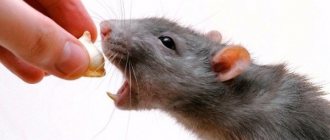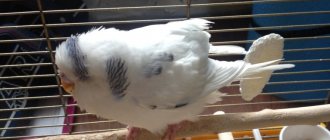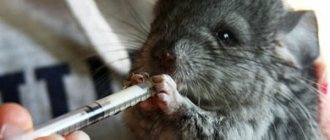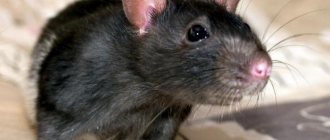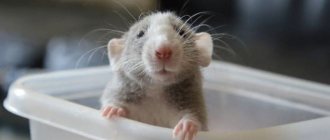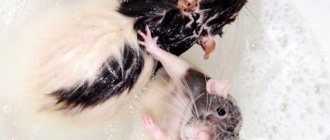Any animal that a person gets at home requires adequate care and maintenance. Without the right attitude towards your pet, he will definitely get sick. Therefore, you need to ask yourself the question: are you ready to take responsibility for the animal? Before buying a specific animal, you need to at least minimally study the rules of its maintenance, nutrition and possible diseases.
One of the most common pets is the decorative rat. She is not as aggressive as her street counterparts and does not tolerate infections (unless, of course, she was initially sick). Most rodents are affectionate and respond well to human interaction. However, no owner is insured against possible pet diseases. Therefore, you need to know what diseases rats suffer from, how to treat them, and what preventive measures to take to protect the animal.
Reasons why a rat may be choking or panting?
Attention! Due to the rapid metabolism of the decorative rat, diseases progress very quickly. It is impossible to identify them, much less cure them at home. Therefore, in case of any deviations in the breathing process, you must contact a veterinarian or, even better, a ratologist.
If extraneous sounds are heard during breathing (wheezing, whistling, etc.), it becomes confused or the animal is suffocating, this may be the cause of various diseases.
Respiratory diseases (bronchitis, pneumonia, asthma)
A rat's heavy breathing is a bad sign.
Sometimes even a common cold can cause more serious illnesses, resulting in death. For respiratory diseases, the following symptoms are distinguished:
– the rat constantly grunts and sneezes;
– dried brownish mucus appears on the nose and eyes, it is called porphyrin;
– a characteristic whistle is heard, the animal breathes frequently and unnaturally from its sides;
– there is a cough of varying intensity and humidity, wheezing and gurgling are heard when breathing, the rat opens its mouth;
– in neglected situations, the rat characteristically hunches its back, moves little and often sleeps;
– in severe cases of the disease, the rodent refuses to eat, apathy, ruffled fur, and mucous discharge from the eyes and nose are observed.
Have you noticed similar signs in your rodent?
Cardiovascular diseases (heart failure, heart attack, stroke)
Heart failure can occur in any rat, regardless of age. This disease also causes striking symptoms:
Is the rat grunting? Let's run to the vet!
– the animal gains weight sharply, a huge belly appears;
– sometimes the opposite situation occurs: the rodent quickly loses weight, the fur becomes dull and disheveled;
– the domestic rat loses activity, becomes easily fatigued, and the animal sleeps a lot;
– breathing becomes wet and heavy, the rodent grunts, wheezes and coughs;
– the tips of the animal’s tail and fingers become cold and blue, the hind legs are weakened.
Older, older rats may have a heart attack or stroke.
These diseases are characterized by the following symptoms:
– the animal falls on its side and convulses;
– the rodent opens its mouth and gasps;
– limbs move involuntarily.
Note: Cardiovascular and respiratory diseases may present with similar symptoms, but the treatment required is completely different. Therefore, it is impossible to diagnose and treat an animal on your own, without the help of a specialist.
If a rat is breathing heavily, this is not normal!
Key points in emergency care
If a rat has problems breathing, it must be taken to a veterinarian. He will carry out the following procedures:
- Provide humidified oxygen if necessary.
- Give your pet saline or antibiotics.
- Prescribe parenteral antibiotics such as oxytetracilline (60 mg/kg intramuscularly every 72 hours) or long-acting doxycycline.
- Feed the pet. The owner can help feed the rat using a syringe.
The veterinarian will also ask you about the clinical disease, as well as all the details associated with caring for the rat (housing, diet, cage mates). This is necessary for an accurate diagnosis.
How to help a rat if it is panting, choking or grunting
Common causes of shortness of breath and breathing problems in rats are pneumonia and heart attack.
The most important thing to do is contact a veterinarian. Only a specialist can prescribe adequate treatment. If wheezing or other breathing problems occur, you can provide your pet with first aid and additional measures to the main treatment.
In case of a heart attack, when the animal is breathing heavily and making wheezing sounds, you must definitely pay attention to the tail and ears (they turn pale); fingers and tail tip (turns blue). Convulsions begin, the animal moves its limbs chaotically.
To provide first aid to the animal, you need to drop a few drops of Corvalol into the rodent’s mouth and rush to the veterinarian as soon as possible. Try to handle your pet as little as possible during an attack. In this state, he is capable of injuring your hand with a bite. Because of this, the animal may fall, which will further aggravate the situation. You should remove all unnecessary and traumatic objects (tunnels, ladders) from the cage. During an attack, the rat does not control itself and can injure itself.
Reference : pneumonia in rats is an infection that affects the animal’s lungs. Inflammatory processes occur in the rodent's respiratory organs.
If your rat is sneezing more than usual, listen carefully to the animal's breathing. In the case when the breathing is even, there are no mucous discharges from the nose, you just need to observe the behavior of the animal. You should not start treatment until you are sure that the animal is actually sick. The cause of sneezing may be a simple allergy or dust.
If the animal makes unnatural, grunting sounds, your rat is sick! Contact your veterinarian immediately!
Grunting sounds in the sinuses indicate that they are full and breathing is difficult . The disease progresses very quickly, so it is worth taking steps to consult a veterinarian. Based on the diagnosis, he will prescribe a course of antibiotics.
Important! You can become resistant to an antibiotic. Because of this, you will have to start all over again, but with a different, stronger medicine that can cause even more harm to the animal. Therefore, a clear diagnosis by a specialist is needed.
Ratologist will help save the rat
Measures to restore animal health
In order to cure your pet as quickly as possible, in addition to a course of antibiotics, it is necessary to take measures to restore the animal.
– The rodent’s cage must be reliably protected from drafts. – The room in which the cage is located should have normal air humidity . It should not be overdried.
– The cage should be thoroughly cleaned daily: the ammonia smell irritates the animal’s nose and breathing.
– A heating pad installed in the cage also promotes recovery.
– Echinacea decoction will help strengthen the rat's immune system.
– If the pet is not alone, you need to seat the animals in different cages to prevent the spread of infection.
Diagnostics
Although definitive diagnosis is difficult, mycoplasmosis is very common and well recognized in rats. The presumptive diagnosis of mycoplasmosis is usually based on characteristic clinical signs.
- Survey radiographs
X-rays can usually be performed without sedating or anesthetizing the pet rat. Get two views, as with other mammals. Assessing lung lesions can help determine prognosis and monitor response to therapy.
- Bacterial culture and sensitivity testing
Collecting in-depth diagnostic samples from pet rats may not be possible, although some clinicians will submit respiratory secretions for analysis. Mycoplasma spp. difficult to isolate because it cannot be grown by conventional cultivation methods.
- Blood analysis
A general blood test will help determine the degree of the inflammatory process.
How to treat?
Medications are often used to treat vasomotor rhinitis. For cold rhinitis, you first need to limit contact with the trigger (provoking factor): cold air, water or food. You should not wash your face or hands with cold water, take a contrast shower, or visit baths, saunas and other places with a sharp temperature change. Also avoid drafts and hypothermia 4. However, hardening will be useful to prevent cold rhinitis, so consult your doctor. Find out whether you can start hardening after treatment, and what hardening procedures are best to start with.
In the cold season, when it is impossible to completely avoid contact with cold air, treatment with medications is necessary.
To treat various forms of vasomotor rhinitis, 5 drugs are used:
- Intranasal glucocorticosteroids . The drugs have a wide spectrum of action and they cope with inflammation or hyperreactivity, and as a result make it easier to breathe through the nose and reduce swelling.
- Histamine receptor blockers . The drugs are used for allergic and vasomotor rhinitis, relieve swelling, reduce inflammation.
- Nasal sprays based on sea water . Irrigation therapy (or nasal rinsing) maintains the protective properties of the nasal mucosa and improves the discharge of mucous secretions.
For the treatment of any form of vasomotor rhinitis, it is not recommended to use vasoconstrictor drops. They cause rapid addiction (within 7-10 days), after which withdrawal syndrome is possible. With vasomotor rhinitis, when the autonomic nervous system of the nasal cavity is imbalanced, vasoconstrictor medications can only aggravate the disease and contribute to a longer course of the disease 5.
When is palpitations a reason to see a doctor?
A rapid heartbeat is a reason to see a doctor if it:
- too intense;
- is protracted (does not go away for a long time);
- occurs with less and less exposure to the above factors;
- occurs independently of the above factors;
- is uneven in nature (arrhythmia can be assumed - a violation of the heart rhythm).
In these cases, rapid heartbeat may be a manifestation of serious disorders and diseases, such as:
- avitaminosis;
- anemia (low hemoglobin and iron in the blood);
- tetany (a condition caused by a lack of calcium);
- endocrine diseases;
- heart pathologies.
However, as a rule, in the case of myocarditis, other heart diseases, and hyperthyroidism, palpitations are not the main complaint. With such diseases, first of all, they complain of pain in the heart and shortness of breath.
It is necessary to react promptly if, against the background of increased heartbeat, dizziness, shortness of breath, pale skin, and sweating are observed. In this case, you should call an ambulance.
Increased heart rate and high blood pressure
Increased heart rate is often accompanied by increased blood pressure. In this case, the more often the heart contracts, the higher the pressure in the arteries. The dependence here is exactly that... Therefore, it is wrong to consider high blood pressure as the cause of increased heart rate. Another thing is that increased blood pressure, accompanied by a general deterioration in well-being, can make you notice how hard your heart is beating.
Rapid heartbeat and increased blood pressure can be caused by the same reasons. In this case, therapeutic measures aimed at normalizing blood pressure will also help normalize the heartbeat.
Forecast
Rat respiratory mycoplasmosis is usually a chronic disease, but early treatment reduces the severity and duration of the disease.
Antimicrobial therapy may not completely eliminate the infectious agent, so treatment is often necessary to repeat. Infected rats usually remain a potential source of disease transmission to other rats throughout their lives.
Increased heart rate and low blood pressure
An increased heart rate is quite possible even with low blood pressure. A sharp decrease in blood pressure can be observed during shock conditions (anaphylactic, traumatic, infectious-toxic, psychogenic and other types of shock). The body responds by speeding up the contraction of the heart muscle to restore blood pressure. A similar compensatory nature of increased heartbeat also occurs with large blood loss.
Injuries in rodents
Injuries, bruises, fractures in rodents
Can occur when falling from a height or improperly restraining the animal. Sometimes tissue or limbs are pinched. Injury is caused by using cotton wool as bedding instead of hay or sawdust. Lameness that progresses to complete impairment of limb function can result in self-amputation of the paw, especially in hamsters and rats.
Fractures and cracks of bones in rodents
They can happen while playing with children or fighting among themselves, when the cage door is quickly slammed shut. Characteristic signs are that the animal squeals in pain, swelling of the limb, lameness, and hematoma appear. With an open fracture, the bones break through the soft tissue and come out. It is necessary to immediately limit mobility, transfer the rodent to a small box or carrier, and take it to a veterinary clinic for treatment. Bites and wounds occur as a result of a fight with another animal. The wound should be washed with an antiseptic solution (for example, an aqueous solution of Chlorhexidine 0.05%) or saline, the rodent should be transferred to a small cage or box and taken to a veterinary clinic.
Self-treatment of rodents in case of injuries is not recommended, since wounds can become infected, and fractures can lead to further improper healing of bones or complete loss of a limb.


